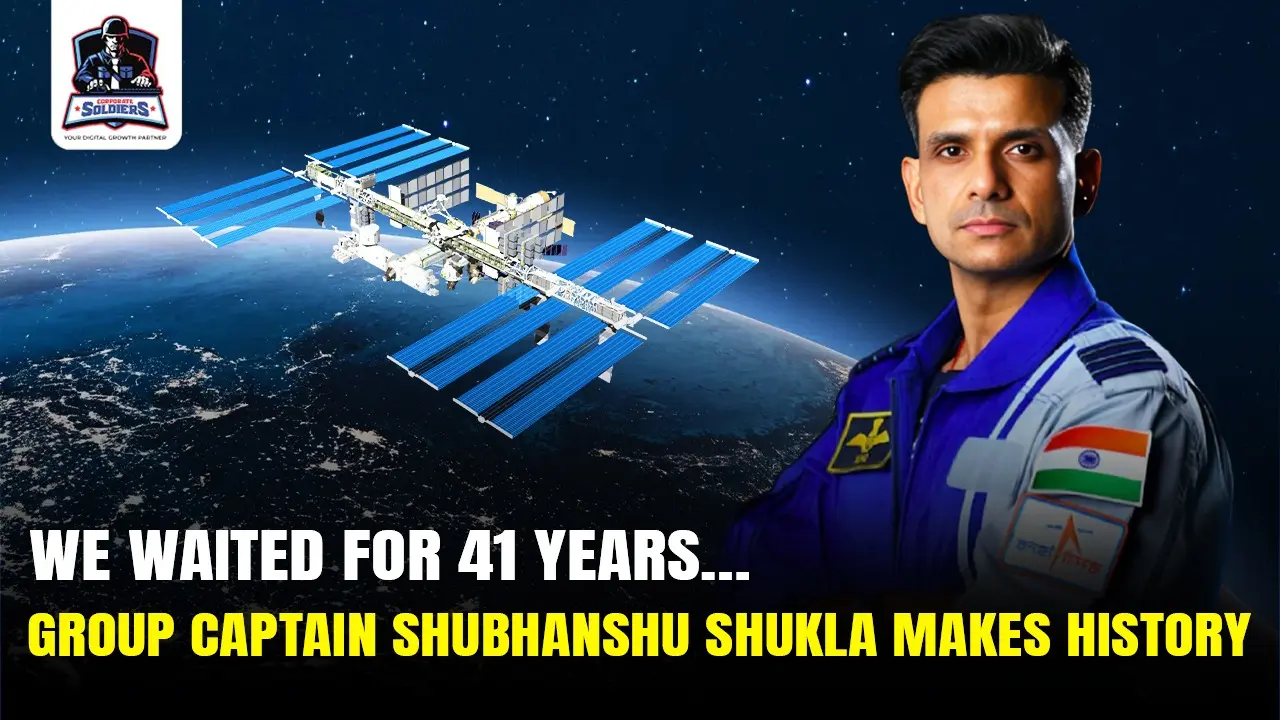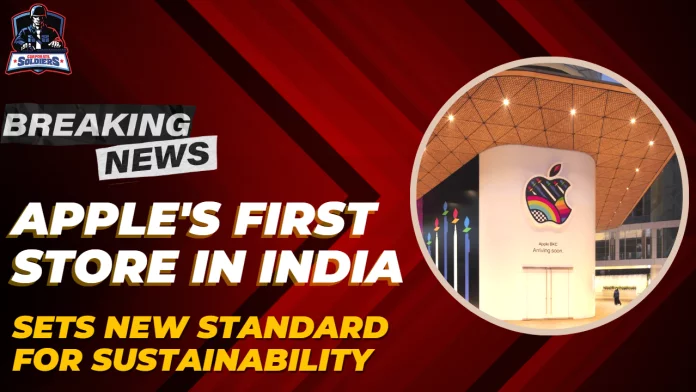‘Look up at the stars and not down at your feet. Try to make sense of what you see, and wonder about what makes the universe exist. Be curious.’ – Stephen Hawking
Finally, the moment is here and we waited for this moment to happen for 41 years. India has once again scripted its name among the stars. It’s a moment to remember. A moment that has captured India’s name in gold once again. What kind of gold? A golden journey that rekindles the nation’s celestial dreams. Group Captain Shubhanshu Shukla’s journey into the cosmos is a historic moment for India. As the world watched, he soared beyond the blue, carrying not just the tricolor, but the hopes and curiosity of a billion hearts. After Squadron Leader Rakesh Sharma (1984), he became the second Indian citizen to do so. The gap is quite long though, however, at last, it was Shubhanshu Shukla who did it.
India is proud of this Indian Air Force officer and ISRO astronaut who has now commenced research activities aboard the International Space Station (ISS). He is a part of Axiom Mission 4 (Ax-4). After so many technical and weather-related delays, finally, this mission is on. Why is this mission so special? It is India’s return to human spaceflight after four decades.
Let’s see the journey!
Let’s Recall Rakesh Sharma, India’s First Space Pioneer!
Back in 1984, when disco ruled the airwaves and Doordarshan was the king, Squadron Leader Rakesh Sharma became our first Indian space hero. His Soyuz T-11 mission wasn’t just a flight; it was a national event that glued the country to their TV screens. Our hearts were swelling with pride. Sharma’s calm, yogic composure in zero gravity and his now-legendary ‘Saare Jahan Se Achha’ response to Prime Minister Indira Gandhi turned him into a living legend overnight. Floating in Salyut 7, he was more than an astronaut, he was India’s ambassador to the universe, proving that Indian ingenuity and spirit could reach for the stars.
Shukla’s presence on the ISS is a new milestone for all of us. India’s space ambitions are flying high and so are our hopes. He is the first Indian to reach the ISS and the first to fly in space since Rakesh Sharma’s legendary 1984 mission. Carrying the Indian tricolour into orbit, Shukla’s journey will be seen as the dawn of India’s full-fledged human space programme, with the Gaganyaan mission on the horizon.
Why Axiom-4 is Special?
Every year counts for new things but for global cosmic ambitions, the year 2025 counts for new trends. Trends that break barriers and set new examples for all of us. The collaboration between ISRO, NASA, SpaceX, and Axiom Space is the beginning of this change. Change where India is showing the world that it can blend tradition with innovation. Shukla’s presence symbolizes it. The experiments he will conduct at the ISS hold hope for the future. The future of sustainable living in space. From microalgae to moong sprouts, these astronauts are looking for possibilities of a new hope.
Meet The Crew!
The mission has brought together a global team of astronauts. Apart from Group Captain Shubhanshu Shukla, Commander Peggy Whitson from the USA, Slawosz Uznanski-Wisniewski from Poland, and Tibor Kapu from Hungary, are on this mission. They traveled to the International Space Station aboard the SpaceX Dragon spacecraft. The spacecraft was launched by a Falcon 9 rocket. It is quite a moment of awe because not only it’s a global collaboration but also about how advanced and reliable modern space travel has become.
The Dragon spacecraft arrived at the ISS ahead of schedule and docked smoothly at the Harmony module’s space-facing port. NASA engineers Anne McClain and Nichole Ayers closely monitored the automated docking, ensuring everything went perfectly. All fell in perfect sync and we hope for the same in the future as well. A successful mission is all about teamwork and technology in today’s space exploration.
| Experiment | Crew Members | Focus | Purpose |
| Neuro Motion VR | Shubhanshu Shukla and all crew | Cognitive and motor function | How spaceflight affects the brain and body, aiding astronaut health and mission performance |
| Cancer in LEO (Low-Earth Orbit) | Peggy Whitson | Cancer cell growth and drug response in microgravity | How aggressive cancers behave in space and develop better treatments in collab with Sanford Stem Cell Institute |
| Microfluidic Design | Slawosz Uznanski-Wisniewski | Fluid dynamics and drug testing device development | To create a way for autonomous drug testing and advanced medical research in orbit |
| Telemetric Health AI | All Crew | Biometric and mission data analysis using AI | To monitor cardiovascular and balance system changes |
This mission is a massive global collaboration and connecting people all over the world. It brings together about 60 research activities from 31 different nations. Shukla and his crew are talking with students, researchers, and leaders from many different countries. Hungarian astronaut Tibor Kapu on the mission connected on call with his Prime Minister, Viktor Orban. At the same time, Peggy Whitson Whitson documented student experiments from the Saudi Space Agency’s Microgravity Challenge, which drew over 80,000 submissions from the Arab world. These kinds of activities are making the International Space Station feel like a lively, global classroom and a place for diplomatic partnership.
Group Captain Shubhanshu Shukla’s Journey and His Role
From the busy streets of Lucknow to the silence of space, Shukla’s journey tells the story of grit, brains, and a dash of cosmic luck. NDA graduate and MTech in Aerospace Engineering from IISc Bengaluru, commissioned into the Indian Air Force in 2006, Shubhanshu has over 2,000 hours of flying experience on frontline aircraft such as the Su-30 MKI, MiG-29, Jaguar, and Dornier-228. Trained in Russia and India, fluent in the language of jets and rockets, he represents the new-age Indian astronaut. The new-age Indian astronaut who is globally savvy, scientifically sharp, and unafraid to dream big. His mission aboard Axiom-4 isn’t just a personal milestone; it’s a bold statement that India is ready to play in the league of cosmic explorers.
His several microgravity experiments were selected by ISRO and they have a strong focus on microalgae research. He is carrying out experiments on ISS as well. On his third day aboard the ISS, Shukla imaged algae strains and sample bags. He is investigating their viability as sustainable food sources for future long-duration missions.
This research is important because it could help us create a sustainable, healthy food source for astronauts on long space trips. It’s a big help for India’s own astronaut program, Gaganyaan, as we are looking for new ways to support our astronauts. Besides algae, Shukla is also studying how muscles get weaker in space. As we know muscles and bone density get weaker in space. This is a major challenge for astronauts. Shukla’s learnings could also lead to new treatments for muscle-wasting diseases on Earth as well.
New India is Shining!
As Shubhanshu Shukla floats in microgravity, India’s hopes are high. His journey is not just a personal achievement but a collective leap for our nation. We are ready to claim our place among the stars. If Rakesh Sharma was the pioneer who opened the cosmic door, Shubhanshu Shukla is the new light walking through it. Sharma’s era was one of analog controls and Cold War partnerships; Shukla’s world is digital, global, and commercial. It’s just the beginning, isn’t it? In anticipation of a cosmic future, we, Corporate Soldiers bid you goodbye for now!










